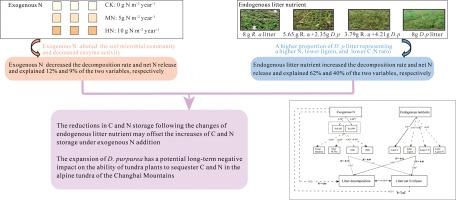Science of the Total Environment ( IF 9.8 ) Pub Date : 2021-09-17 , DOI: 10.1016/j.scitotenv.2021.150388 Yingjie Zhang 1 , Yinghua Jin 1 , Jiawei Xu 1 , Hongshi He 2 , Yan Tao 1 , Zhipeng Yang 1 , Yunyu Bai 1

|
The effects of N deposition on the C and N cycles via altered litter decomposition rates are an important aspect of global environmental change. The Changbai Mountain region experienced a high N deposition (2.7 g·m−2·year−1 in 2015) and corresponding expansion of Deyeuxia purpurea into the alpine tundra, resulting in changes in endogenous nutrients. However, the relative contributions of the N deposition and endogenous litter nutrients to litter decompositions remain unclear. Therefore, a 5-year N addition and 2-year litter decomposition experiments were conducted. Exogenous N reduced the remaining litter mass of Rhododendron aureum at the early stage (30–240 d) by promoting soluble sugar release, and increased it at the late stage (360–720 d) by suppressing lignin release and decreasing soil microbial community and enzyme activity. A higher proportion of D. purpurea litter (representing higher N, lower lignin, and C:N ratio) decreased remaining litter mass and increased net N release. Exogenous N decreased decomposition rate from 0.32 to 0.21 and net N release from 34% to 24%, whereas litter compositions increased decomposition rates from 0.32 to 0.69 and net litter N release from 34% to 69%. Endogenous litter nutrients directly explained 62% and 40% of the litter decomposition and net N release variables, respectively, whereas exogenous N indirectly explained 12% and 9%, respectively. Thus, we infer that the reductions in C and N storage following D. purpurea expansion may offset the increases of C and N storage under N deposition and the expansion of D. purpurea has a potential long-term negative impact on the ability of tundra plants to sequester C and N in the alpine tundra of the Changbai Mountains. These findings highlight how shifting plant expansion, through changes endogenous nutrients, can influence tundra litter decomposition and C and N storage responses to N deposition.
中文翻译:

外源氮和内源养分对高氮沉积区高寒苔原凋落物分解的影响
N 沉积通过改变凋落物分解率对 C 和 N 循环的影响是全球环境变化的一个重要方面。长白山地区经历了高氮沉降(2015年为2.7 g·m -2 ·year -1),相应的德叶夏紫菜向高山苔原扩张,导致内源养分发生变化。然而,氮沉积和内源性凋落物养分对凋落物分解的相对贡献仍不清楚。因此,进行了 5 年的 N 添加和 2 年的凋落物分解实验。外源氮减少了金黄色杜鹃花的剩余凋落物质量在早期(30-240 d)通过促进可溶性糖释放,并在后期(360-720 d)通过抑制木质素释放和降低土壤微生物群落和酶活性而增加它。更高比例的D. purpurea凋落物(代表较高的 N、较低的木质素和 C:N 比)减少了剩余的凋落物质量并增加了净 N 释放。外源氮将分解率从 0.32 降低到 0.21,将 N 净释放量从 34% 降低到 24%,而垫料成分将分解率从 0.32 提高到 0.69,将垫料 N 净释放量从 34% 提高到 69%。内源凋落物养分分别直接解释了 62% 和 40% 的凋落物分解和净氮释放变量,而外源氮分别间接解释了 12% 和 9%。因此,我们推断,在以下的C和N存储的削减D.菊膨胀可以抵消的C和N个存储下N沉降的增加和扩大D.菊对长白山高寒苔原苔原植物固存碳和氮的能力有潜在的长期负面影响。这些发现强调了植物扩张的转移如何通过改变内源养分来影响苔原凋落物的分解以及对氮沉积的碳和氮储存响应。



























 京公网安备 11010802027423号
京公网安备 11010802027423号